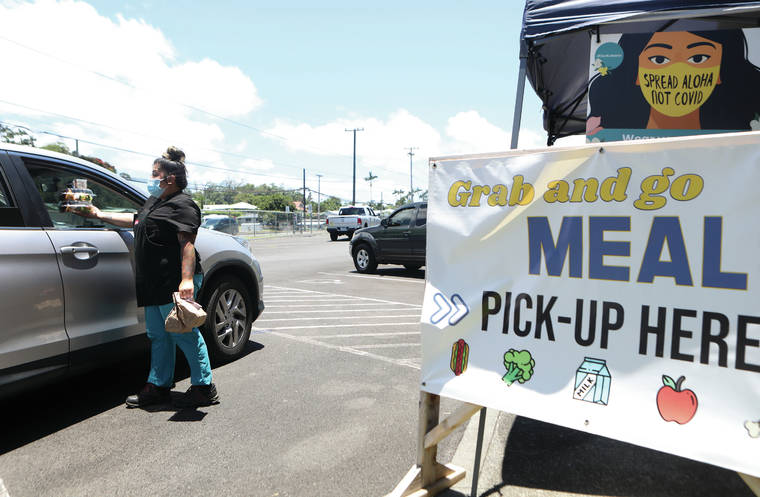More than a month after announcing public schools in Hawaii will open fully for daily-in person learning in August, state Superintendent Christina Kishimoto said face-to-face instruction will be the “primary mode of instruction” when students return for the new academic year.
Although some distance-learning opportunities will be needed for families who might have someone ill at home or who have members at high risk for COVID-19, Kishimoto said during a livestream Monday that those families and principals will have conversations “to see how schools can accommodate those requests.”
“We are not doing necessarily a full distance-learning option for every family,” she said.
According to Kishimoto, many students did not do well with distance learning. Families are asking for in-person instruction, she said, “so we want teachers at the helm, teaching those students in schools.”
Additionally, the superintendent said there’s no additional funding for the Department of Education to add teacher positions. She said there currently aren’t enough teachers to provide both in-person instruction and distance learning.
Because of the pandemic, DOE schools have not fully reopened to in-person instruction since March 13, 2020.
“I’m excited about the new school year,” Kishimoto said. “… It’s really important after such a difficult year and quarter … away from normal schooling to have our kids back with their peers, with their teachers, with their support staff and their teams to be learning and fully engaged again.”
Kishimoto said schools will reopen with safety precautions in place, including a mask requirement on school campuses, continued hand washing and sanitizing, and remaining home when feeling ill.
“We will not be doing the kind of social distancing that we’ve required in the past in order to have all students back on campus, but this has been approved by the (state) Department of Health,” she said.
Given that keiki under 12 cannot yet be vaccinated against COVID-19, Kishimoto said it’s important that the majority of adults and individuals 12 and older — those who can be vaccinated — are inoculated.
“That creates a safe environment for our kids who are 12 and under and allows the opportunity for everyone to be safe,” she said.
According to the superintendent, the DOE is not requiring students to show proof of vaccination at this time.
“We are continuing to work with DOH around how to ensure that every step we take along the way is approved by them and is guided by the health experts,” she said.
Kishimoto also spoke about the “extremely difficult” and “disappointing” 2021 legislative session and drastic budget cuts implemented by the state Legislature.
“In the midst of a pandemic, the DOE had $100 million taken from kids. And that’s the best way I can put it out very specifically,” she said. “$100 million (was) cut from our budget during a time when we needed more funding for devices, connectivity, food services, wrap-around supports, getting to isolated communities in different ways. We were spending more, and we had $100 million cut.
“What was really disappointing was I was brought to the table and asked, ‘Can you spare $100 million up front, we will restore it,’ and at the end of the day, not only was it not restored, it was made a permanent cut,” she continued. “And that’s disappointing, because it’s money that should be going to kids.”
According to Kishimoto, the DOE received $412 million in federal coronavirus relief funds, for which the department is grateful, but “we’re catching up on unpaid bills” to ensure a balanced budget heading into the new school year.
“At the end of the year, we have about a $200 million cut to our budget still, and I’m hoping that with revenues increasing that that money will be restored to children, to their future. That that money is put back,” she said.
Kishimoto also said that even after meeting with state leaders early in the pandemic and speaking about the need for funding for student devices and connectivity, the Legislature allocated no money for that purpose.
“Thankfully, the governor came through and was able to provide … $34, $35 million to buy some of the additional devices, but we needed about $100 million,” she explained. “So this has been an unusually difficult year when we really needed our influencers, our leaders, our decision makers to stand up for kids, and I don’t know that from a policy perspective that I saw folks follow through in the way they should have for our children.”
Kishimoto’s livestream interview comes in the waning days of her DOE leadership.
Tapped to lead the department nearly four years ago, Kishimoto announced in March that she would not seek to renew her contract. Her last day with the DOE is July 30.
Waipahu High School Principal Keith Hayashi was recently appointed interim superintendent beginning no later than Aug. 1.
Kishimoto said she will remain in Hawaii after stepping down.
“Hawaii’s home. I love this place,” she said. “There’s a lot of work still to be done on the equity front. I will be continuing to lean in very heavily into equity of access for our children, and working on gender equity in terms of women empowerment and voice, and I’m excited about the work I’m going to be doing there.”
Email Stephanie Salmons at ssalmons@hawaiitribune-herald.com






